Light
Light is a form of energy that allows us to see the world around us. It is made up of tiny particles called photons that travel in waves. These waves can vary in length and frequency, which determines the color and intensity of the light. Light can also be reflected, refracted, and absorbed by different materials and surfaces.
Properties of Light
There are several key properties of light that are important to understand:
- Reflection: When light bounces off a surface, such as a mirror, it is called reflection. This is how we are able to see objects that do not emit their own light.
- Refraction: When light passes through a material, such as water or glass, it can change direction. This is known as refraction and is why objects appear distorted when viewed through water.
- Absorption: When light is taken in by a material, it is absorbed. This is why dark-colored objects get warm in the sunlight, as they absorb more light energy.
- Transparency: Materials that allow light to pass through without being scattered are transparent. Examples include glass and clear plastic.
- Color: Different colors of light have different wavelengths. When all wavelengths are combined, we see white light. When no wavelengths are present, we see black.
Sources of Light
There are two main sources of light: natural and artificial.
- Natural Light: The sun is the primary source of natural light. It emits a wide range of light wavelengths, providing energy for plants to grow and allowing us to see during the day.
- Artificial Light: This includes light produced by human-made sources such as light bulbs, candles, and flashlights. These sources use electricity, heat, or chemical reactions to produce light.
Study Guide
To study the topic of light, here are some key points to focus on:
- Describe the properties of light and provide examples for each.
- Explain how light behaves when it is reflected and refracted.
- Discuss the different colors of light and how they are produced.
- Differentiate between natural and artificial sources of light, and provide examples of each.
- Explore the practical applications of light in everyday life, such as in photography, vision, and communication.
Understanding the properties and behavior of light is essential for comprehending how we see the world and the technology we use every day.
[Light] Related Worksheets and Study Guides:
.◂Science Worksheets and Study Guides Second Grade. Comparing matter
Study Guide Comparing matter
Comparing matter  Activity Lesson
Activity Lesson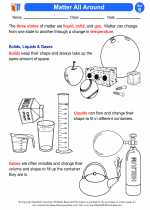 Matter All Around
Matter All Around  Worksheet/Answer key
Worksheet/Answer key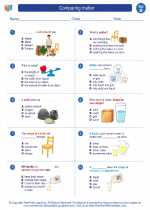 Comparing matter
Comparing matter  Worksheet/Answer key
Worksheet/Answer key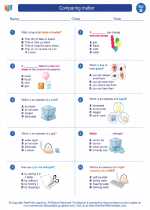 Comparing matter
Comparing matter  Worksheet/Answer key
Worksheet/Answer key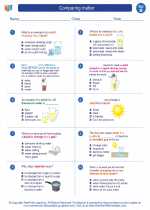 Comparing matter
Comparing matter  Vocabulary/Answer key
Vocabulary/Answer key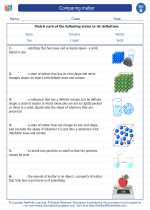 Comparing matter
Comparing matter 

 Activity Lesson
Activity Lesson
 Worksheet/Answer key
Worksheet/Answer key
 Worksheet/Answer key
Worksheet/Answer key
 Worksheet/Answer key
Worksheet/Answer key
 Vocabulary/Answer key
Vocabulary/Answer key

The resources above cover the following skills:
PHYSICAL SCIENCE (NGSS)
Matter and its Interactions
Students who demonstrate understanding can:
Construct an argument with evidence that some changes caused by heating or cooling can be reversed and some cannot.